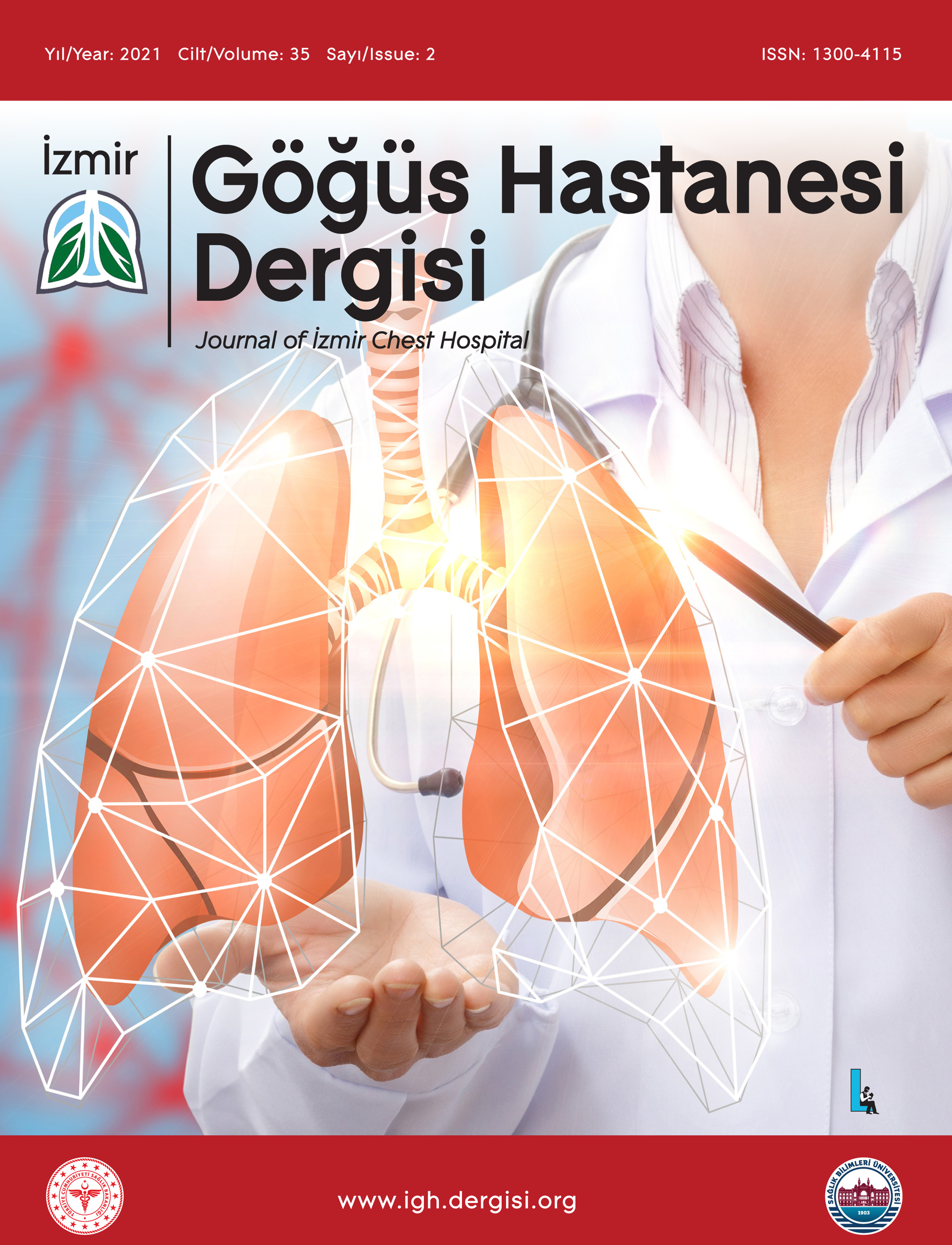AKCİĞER KANSERLERİNDE ALT EKSTREMİTE DERİN VEN TROMBOZU İNSİDANSININ RENKLİ DOPPLER ULTRASONOGRAFİ İLE ARAŞTIRILMASI
Hülya DOĞAN1, Nimet AKSEL1, Mahmut ÖKSÜZLER2, Aydan ÇAKAN1, Ayşe ÖZSÖZ1, Mustafa SEÇİL21Göğüs Hastalıkları ve Cerrahisi Eğitim ve Araştırma Hastanesi, Göğüs Hastalıkları Kliniği, İzmir2Dokuz Eylül Üniversitesi Tıp Fakültesi, Radyoloji Anabilim Dalı, İzmir
Tromboembolik hastalık kanser hastalarında mortalite ve morbiditeyi etkileyen önemli faktörlerden biridir. Kanser hastalarında ikinci sıklıkta ölüm nedeni trombozdur. Çalışmamızda akciğer kanseri tanısı konan hastalarda tanı anında alt ekstremite derin ven trombozu görülme sıklığının renkli doppler ultrasonografi ile saptanması amaçlandı. Akciğer kanseri tanısı alan 50 hasta semptomlar, eşlik eden hastalık, venöz tromboemboliye predispozisyon yaratan durumlar açısından sorgulandı. Radyolojik, bronkoskopik ve sitopatolojik özellikleri tespit edildi. Evreleri, tedavi rejimleri ve metastaz yerleri saptandı. Toplam 16 hastada eşlik eden hastalık tespit edildi. Bir hasta kolon tümörü nedeniyle opere olmuştu. Dördü kadın, ikisi erkek olmak üzere 6 hastanın dışında tüm hastalar sigara içiyordu. Koagülasyon testleri 8 hastada bozulmuştu. 15 hastada trombositoz saptanırken sadece bir hastada polisitemi saptandı. Arteryel kan gazlarında; 17 hastada hipoksi, 8 hastada hiperkapni gözlendi. Patolojik olara k 10 hasta küçük hücreli, 38 hasta küçük hücreli dışı akciğer kanseri, 2 hasta ise indiferan karsinom tanısı aldı. Bir hasta evre IIA, 2 hasta evre IIB, bir hasta evre IIIA, 22 hasta evre IIIB ve 14 hasta evre IV olarak değerlendirildi. Çalışmada yer alan tüm hastalara alt ekstremite renkli doppler ultrasonografi incelemesi yapıldı; hepsinde bilateral alt ekstremite derin venöz sistemi patent olarak izlendi, tromboze görünüm saptanmadı. Bu çalışmada, henüz tedavi uygulanmamış olan akciğer kanserli hastalarda derin ven trombozunun klinik bulguları olmadan, rutin olarak tarama amaçlı alt ekstremite renkli doppler ultrasonografi incelemesinin gerekli olmadığı sonucuna varıldı. Bu konuda daha geniş hasta gruplarında yapılan çalışmalara gerek vardır.
Anahtar Kelimeler: Akciğer kanseri, derin ven trombozuINVESTIGATION OF INCIDENCE OF LOWER EXTREMITY DEEP VENOUS THROMBOSIS IN LUNG CANCER BY COLOUR DOPPLER ULTRASONOGRAPHY
Hülya DOĞAN1, Nimet AKSEL1, Mahmut ÖKSÜZLER2, Aydan ÇAKAN1, Ayşe ÖZSÖZ1, Mustafa SEÇİL21Göğüs Hastalıkları ve Cerrahisi Eğitim ve Araştırma Hastanesi, Göğüs Hastalıkları Kliniği, İzmir2Dokuz Eylül Üniversitesi Tıp Fakültesi, Radyoloji Anabilim Dalı, İzmir
Thromboembolic disease is one of the important factors affecting mortality and morbidity in cancer patients. Thrombosis is the second cause of mortality in lung cancer. In this study, it was purposed to determine the incidence of lower extremity deep venous thrombosis in patients with lung cancer at the time of diagnosis by color doppler ultrasonography. Fifty patients, who had been diagnosed as lung cancer, were selected randomisely regardless of clinical symptoms. Cases were asked about factors enhancing risk of thrombosis; comorbidity, history of drugs, operations, smoking, thromboembolic diseases. Cases had comorbidity 32%, history of smoking 88%, history of operation 2%, abnormal coagulation tests 16%, thrombocytosis 30% and polycytemia 2%. In analysis of arteriel blood gases cases exhibited hypoxemia 34%, hypercapnia 16%. In histopathologic examination of bronchoscopic or transthorasic biopsy materials cases were classified as small cell lung cancer 20%, nonsmall cell lung cancer 76% and indifferent carcinoma 4%. In order to determine the stage of the disease, vascular and mediastinal involvement were investigated by thorax computed tomography or magnetic resonans imaging, metastases were investigated by abdominal tomography or ultrasonography. Stage IIA was 2%, stage IIB was 4%, stage IIIA was 2%, stage IIIB 44 % and stage IV was 28%. Lower extremity color doppler ultrasonography exhibited that bilaterally lower extremity deep venous systems were found to be intact in all cases, no thrombosis was shown. In this study it was concluded that searching of lower extremity by color doppler ultrasonography routinely was not necessary in absence of clinical features of deep venous thrombosis. Further researches are needed in wider patient populations about this subject.
Keywords: Lung cancer, deep venous thrombosisMakale Dili: Türkçe






